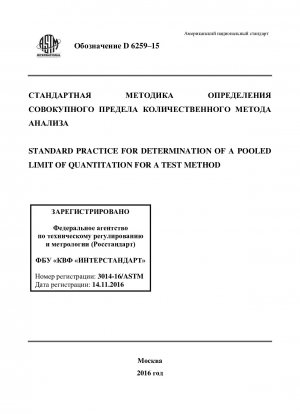ASTM D6259-15
Standard Practice for Determination of a Pooled Limit of Quantitation for a Test Method
- Standard No.
- ASTM D6259-15
- Release Date
- 2015
- Published By
- American Society for Testing and Materials (ASTM)
- Status
- Replace By
- ASTM D6259-15(2019)
- Latest
- ASTM D6259-23
- Scope
5.1 Background—In a single laboratory, the limit of quantitation, LOQ, equal to ten times the standard deviation obtained under repeatability conditions extrapolated to zero concentration (s0) based on samples with close to zero concentrations has been recommended.3 A test result at this LOQ has an uncertainty of ±308201;% at the 998201;% confidence level.
5.1.1 This practice uses a regression technique to determine a similar limit for a test method (PLOQ) using statistically pooled repeatability standard deviations over multiple operators/laboratories/samples from ILS data. This PLOQ can be used by industry to assess the reliability of a test method, or, compare reliability of different test methods, for quantitative measurement at concentrations near zero. Similarly, quantitative test results obtained using the test method for levels at or below the PLOQ can be expected by industry to have an uncertainty of ±30 % or greater at the 95 % confidence level.
5.1.2 The regression technique described in this practice can also be used to determine a limit of quantitation specific for a single laboratory (LLOQ). The limit thus quantified for one laboratory is defined by this standard as the laboratory limit of quantitation (LLOQ).
5.1.3 It should be noted that since differences in repeatability testing capabilities between different laboratories can exist, therefore, LLOQ determined at a single laboratory can be different than the PLOQ determined for the test method.
5.2 Values below the PLOQ are deemed by this practice to be too uncertain for meaningful use in commerce, or in regulatory activities.
1.1 This practice covers the use of standard regression techniques and data from an interlaboratory study to determine a lower quantitative limit for a test method. This determined lower limit represents the numerical limit at or above which the test results are considered to be quantitatively meaningful for commerce or regulatory activities by this practice. It is defined by this standard as the pooled limit of quantitation (PLOQ) for the test method.
1.2 This practice is applicable to test methods that are capable of producing numerical test results close to zero. Examples are those test methods that determine quantitatively the concentration of analyte(s) near zero.
ASTM D6259-15 Referenced Document
- ASTM D6300 Standard Practice for Determination of Precision and Bias Data for Use in Test Methods for Petroleum Products and Lubricants
- ASTM E456 Standard Terminology for Relating to Quality and Statistics
- ASTM E691 Standard Practice for Conducting an Interlaboratory Study to Determine the Precision of a Test Method
ASTM D6259-15 history
- 2023 ASTM D6259-23 Standard Practice for Determination of a Pooled Limit of Quantitation for a Test Method
- 2019 ASTM D6259-15(2019) Standard Practice for Determination of a Pooled Limit of Quantitation for a Test Method
- 2015 ASTM D6259-15 Standard Practice for Determination of a Pooled Limit of Quantitation for a Test Method
- 1998 ASTM D6259-98(2010) Standard Practice for Determination of a Pooled Limit of Quantitation
- 1998 ASTM D6259-98(2004) Standard Practice for Determination of a Pooled Limit of Quantitation
- 1998 ASTM D6259-98 Standard Practice for Determination of a Pooled Limit of Quantitation
